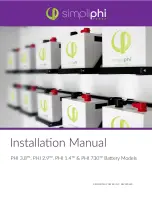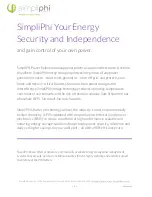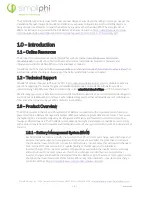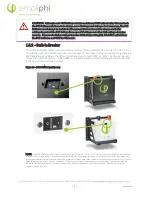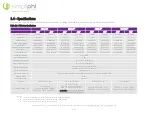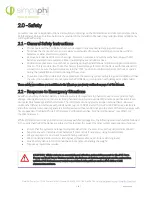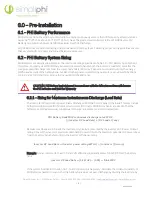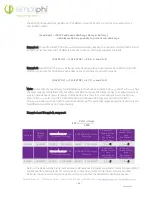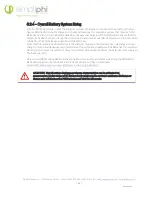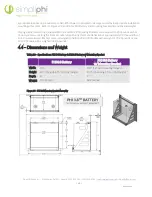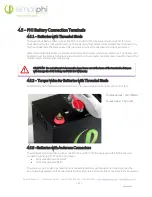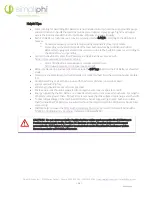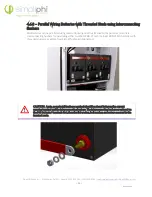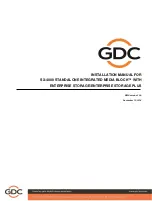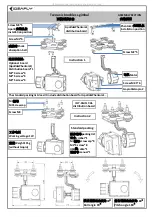
REV020620
SimpliPhi Power, Inc. | 3100 Camino Del Sol | Oxnard, CA 93030, USA | (805) 640-6700 |
| 9 |
3.0
–
Pre-Installation
3.1
–
PHI Battery Performance
PHI Batteries do not need to be de-rated unless running continuously at more than 90% capacity, at temperatures
below 32° F (0° C), or above 113° F (45° C). To achieve the greatest warrantied cycle life of 10,000 cycles, PHI
Batteries are typically operated at 80% maximum Depth of Discharge.
All PHI Batteries are balanced during final production and testing stages. Following proper wiring guidelines ensures
that a system will not require any manual balancing processes.
3.2
–
PHI Battery System Sizing
PHI Batteries are designed to operate at the continuous ratings specified in Table 1.0
–
PHI Battery Specifications.
Therefore, a properly sized PHI Battery bank must be sized to handle both the inverter’s “load rate” as well as t
he
maximum potential charge rate from the solar photovoltaic (PV) array. Take care to consider not only the energy
(kWh) requirement of the battery bank, but also all other power-related sizing parameters, as outlined in Sections
3.2.1, 3.2.2 or 3.2.3 and 3.2.4. Failure to do so will Void the Warranty.
CAUTION: PHI Battery bank sizing not in accordance with the following sections will damage
the PHI batteries and Void the Warranty
3.2.1
–
Sizing for Maximum Instantaneous Discharge (Load Rate)
The load rate is the amount of power that is discharged from the battery bank to the loads. This may include
both alternating current (AC) and/or direct current (DC) loads. PHI Battery banks are sized so that the
batteries’ combined maximum continuous disc
harge rate meets or exceeds the load rate.
𝑃𝐻𝐼 𝐵𝑎𝑡𝑡𝑒𝑟𝑦 𝐵𝑎𝑛𝑘 𝑀𝐴𝑋 𝑐𝑜𝑛𝑡𝑖𝑛𝑢𝑜𝑢𝑠 𝑑𝑖𝑠𝑐ℎ𝑎𝑟𝑔𝑒 𝑟𝑎𝑡𝑒 𝑘𝑊 𝐷𝐶
≥ (𝐼𝑛𝑣𝑒𝑟𝑡𝑒𝑟 𝐷𝐶 𝐿𝑜𝑎𝑑 𝑅𝑎𝑡𝑒) + (𝐷𝐶 𝐿𝑜𝑎𝑑𝑠, 𝑖𝑓 𝑎𝑛𝑦)
Because most loads are AC loads, the load rate is
typically represented by the inverter’s AC Power Output
rating. Convert the inverter’s maximum potential AC power draw to the maximum potential DC power draw
from the battery bank by factoring in the inverter’s efficiency rating.
𝐼𝑛𝑣𝑒𝑟𝑡𝑒𝑟 𝐷𝐶 𝐿𝑜𝑎𝑑 𝑅𝑎𝑡𝑒 = (𝐼𝑛𝑣𝑒𝑟𝑡𝑒𝑟 𝑝𝑜𝑤𝑒𝑟 𝑟𝑎𝑡𝑖𝑛𝑔 𝑘𝑊 𝐴𝐶) ÷ (𝐼𝑛𝑣𝑒𝑟𝑡𝑒𝑟 𝑒𝑓𝑓𝑖𝑐𝑖𝑒𝑛𝑐𝑦)
Example: An inverter rated at 5 kW AC and 92% efficiency potentially draws 5.4 kW DC from the battery
bank.
𝐼𝑛𝑣𝑒𝑟𝑡𝑒𝑟 𝐷𝐶 𝐿𝑜𝑎𝑑 𝑅𝑎𝑡𝑒 = (5 𝑘𝑊 𝐴𝐶) ÷ (0.92) = 𝟓. 𝟒 𝑘𝑊 𝐷𝐶
If the system includes DC Loads, no AC-to-DC conversion is necessary. Calculate the minimum quantity of
PHI Batteries needed to ensure that the battery bank does not over-discharge by dividing the load rate by

